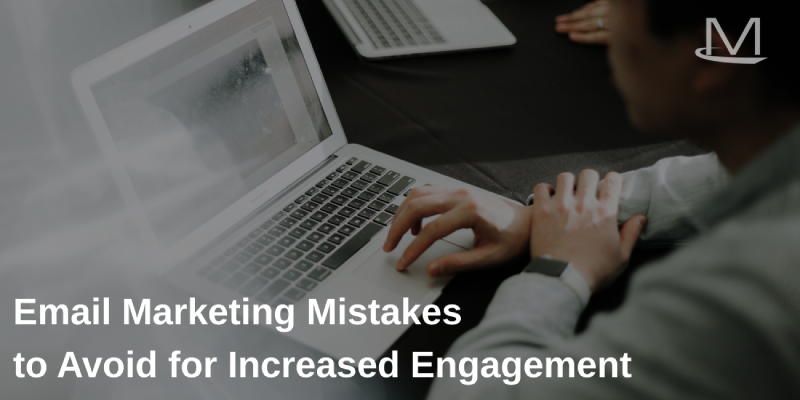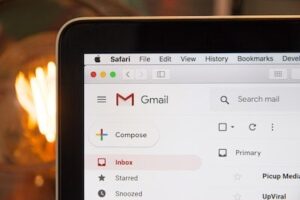
20 Aug Email Marketing Mistakes to Avoid for Increased Engagement
How to Increase Your Email Marketing Engagement
Email marketing can play a large role in the marketing strategy of any organization. However, you must understand email marketing mistakes to avoid, so you can increase engagement and reap the benefits of email as a tool for your business!
Mistakes like sending too many emails, sounding spammy, or not segmenting your list are just some examples of email marketing mistakes to avoid. In this blog post, we’ll share with you several email marketing mistakes to avoid that will help increase engagement in email campaigns.
What is Email Marketing?
Email marketing is a powerful way for you to promote your business and increase profits by reaching out directly to your customers through email. It is one of the most effective forms of digital advertising, with ROI rates up to 200%. Email marketing is simply using email to send out updates, promotions, and news regarding your business to your current or potential customer base.
What Are the Benefits of Email Marketing?
The benefits of email marketing include: building customer loyalty, generating interest in your company and products, increasing sales conversions, and decreasing churn rates, to name a few.
Some studies show that customers prefer to interact with a brand through email than other media such as social networks or even websites. With its low cost-per-engagement rate it is an attractive alternative for companies looking to target busy professionals who don’t want their inboxes flooded with promotional messages from various brands every day.
Why Is Good Engagement Important for Email Marketing?
If your email marketing messages are getting a high engagement rate, you will be able to maximize the budget spent towards this marketing strategy. Additionally, when emails get opened or clicked on by recipients, they can lead to further engagements such as closed deals, increased sales, or new customers.
Key Email Marketing Mistakes to Avoid
Although many organizations attempt email marketing, unfortunately, it is often done incorrectly. We have seen the power email marketing can have when it is done properly! Here are some of the most common mistakes that can cause your engagement to tank:
Sending Too Many Emails
 Too many emails can quickly be overwhelming for your customers. If emails from your organization are constantly flooding their inbox, they will unlikely unsubscribe from your mailing list. However, sending too few emails will likely make your email marketing ineffective.
Too many emails can quickly be overwhelming for your customers. If emails from your organization are constantly flooding their inbox, they will unlikely unsubscribe from your mailing list. However, sending too few emails will likely make your email marketing ineffective.
Aim for sending a minimum of one email per month to your mailing list. At the most, we recommend no more than one or two emails a week as sending more than that may make your emails feel like spam!
For small businesses, monthly blasts are often enough to keep customers informed on your latest news while not overwhelming their already full inboxes.
Using the Same Template Over and Over Again
Using the same template over and over again makes your email look unprofessional and robotic. Take some time to periodically change up templates so you don’t send out an email campaign looking identical to last month’s. This personalization will allow your customers to feel more connected to your brand.
Consider adding a new feature segment each month. Highlight different team members, partners in your company, or even share fun facts about the history of your organization!
Failing to Segment Your Mailing List
Segmenting your mailing list means dividing people into different groups based on who they are as individuals. It gives them content tailored to their interests, which will increase engagement in both reading and clicking links within the email.
If you’re not sure where someone falls in terms of demographics, email content preferences, etc., you can use a survey to ask your customers what information they’re looking for when it comes to emails.
Using Awkward Phrasing for Email Subject Lines
 Subject lines should be straightforward and catchy but not spammy. The subject line is the first (and possibly only) thing that a customer will read. Because of this, it must catch their attention.
Subject lines should be straightforward and catchy but not spammy. The subject line is the first (and possibly only) thing that a customer will read. Because of this, it must catch their attention.
For example: “New product just launched!” is better than “You’ll never believe this amazing deal we have…” Aim for subject lines that clue the reader into what they will find in the email while not revealing the entire subject matter. In this way, you can increase engagement by encouraging recipients to open the email.
Not Responding When People Reply to Emails
Your email should always include contact information in the form of an email address and/or phone number. When people reach out to you in these ways, you must respond!
Responsiveness shows that you care about customer service. If someone reaches out to let you know something wasn’t working correctly with their order (or if they would like more details), make sure to respond and follow up properly. This will ensure that there are no discrepancies between what was emailed and what was actually delivered.
Not Sending Email Campaigns
If you’re not emailing customers, they’ll forget about your business and move on to someone else! It’s a good idea to send email campaigns periodically so that people stay engaged with the company over time.
Far too many companies abandon email marketing for the majority of the year. Once the busy holiday season comes around, they want to start back up. However, they are often quickly discouraged by the lack of engagement! Consistency in this realm will always pay off.
Failing to Optimize Send Time for Your Email
 If you send email campaigns at noon, but your customers are checking their emails between 11 am and noon, then they might not even see it! It’s important to take into account where your recipients are when they’re most likely going to be looking at email.
If you send email campaigns at noon, but your customers are checking their emails between 11 am and noon, then they might not even see it! It’s important to take into account where your recipients are when they’re most likely going to be looking at email.
If you don’t know this information already or if the hours vary for each of your customer segments, try sending email campaigns somewhere in that timeframe. This will increase engagement because people will have a better chance of actually seeing them.
As a general rule, the best engagement is received when you send your emails on Tuesday and Thursday mornings.
Using Words That Sound “Spammy”
Avoid using words like “special” or “urgent”, as these are common spam triggers. Your customers will never have the opportunity to engage with your email if it lands directly in their spam folder!
Not Using a Clear Call to Action
One of the most important things you can do in your email marketing (as well as throughout your website and social media platforms) is to use a clear call to action. A call to action guides recipients so that they know what to do next after opening or clicking on an email!
Examples of a clear call to action for emails include things such as:
- read more here
- call us today
- book your appointment now
- visit our website for more information
Anything that directs the reader on the next step they should take. Bonus points for including a clickable link in your email to make the process simple and streamlined!
Effective Email Marketing for Your Small Business
At McWilliams Media, we have witnessed the tremendous impact that an effective email marketing strategy can have on a small business. Our team of creatives is passionate about helping businesses like yours communicate with your audience in a way that is both authentic and effective.
We will work with you to create an email marketing strategy that will benefit your business and help you create connections with your customer base. Email marketing, when used correctly, could be just the thing you need to level up your online marketing efforts! Are you ready to get started? Contact our team today for more information or to schedule your free strategy session!
Are you interested in learning more about email marketing? Read Email Marketing 101: What Is It & How to Use it Effectively.








